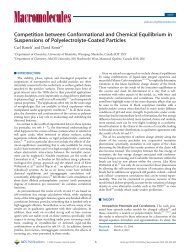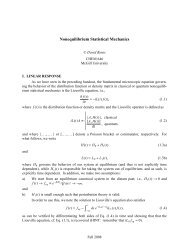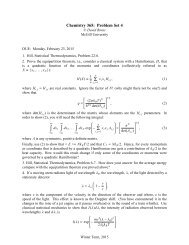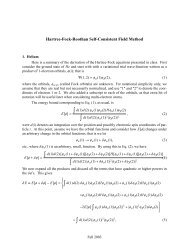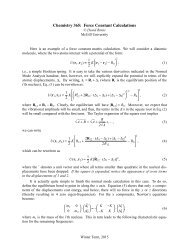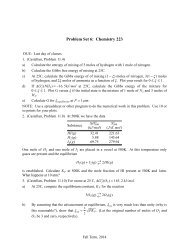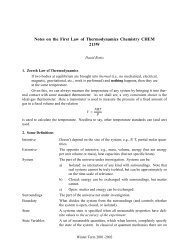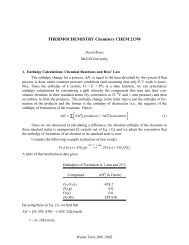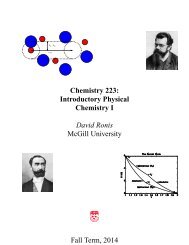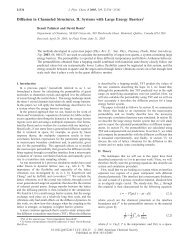Thermodynamic Stability: Free Energy and ... - McGill University
Thermodynamic Stability: Free Energy and ... - McGill University
Thermodynamic Stability: Free Energy and ... - McGill University
Create successful ePaper yourself
Turn your PDF publications into a flip-book with our unique Google optimized e-Paper software.
<strong>Free</strong> <strong>Energy</strong> -12- Chemistry 223principle we expect that the reaction should shift to the left (i.e., less dissociation) as pressure isincreased. Our final equation for α shows this. For this reaction, as we shall see in the next section,K P (T )decreases as temperature increases, which when used with our expression for α isagain consistent with LeChatellier’s principle.5.3. Temperature Dependence of K PThe equilibrium constant, K P ,isonly a function of the temperature. From its definition,cf. Eq. (34),d ln(K P )dT=− d(∆G(0) /RT )dT=− 1 ⎛RT 2 ⎜T d(∆G(0) )−∆G (0)⎞ ⎟ = T ∆S(0) +∆G (0)=⎝dT ⎠RT 2∆H(0)RT 2 ,(39)where the second to last equality follows when Eqs. (27a) <strong>and</strong> (34) are used. This is known asthe Gibbs-Helmholtz equation. Thus, by integrating we find thatln ⎡ K P (T 2 ) ⎤⎢ ⎥ =⎣K P (T 1 ) ∫ T 2⎦(0)∆H ⎛ 1dT ≈ − 1 ⎞RT2R ⎝ T 1 T 2 ⎠ . (40)T 1∆H (0)Equation (40) follows if we assume that ∆H (0) is approximately constant with respect to temperature,or equivalently, that ∆C P ≈ 0(which also implies that ∆S (0) is constant. Why?). Indeed,with this approximation, Eq. (40) simply states thatK P (T 2 ) ⎛K P (T 1 ) = exp ⎜− ∆G(0) (T 2 )+ ∆G(0) (T 1 ) ⎞⎟, (41)⎝RT 2 RT 1 ⎠where ∆G (0) (T ) =∆H (0) − T ∆S o ,asusual. Finally, note, that as in our discussion of LeChatellier’sprinciple, the equilibrium will shift to the product side, i.e., K P increases, when the temperatureis raised if ∆H (0) >0.There is a simple graphical way in which to apply the Gibbs-Helmholtz equation. Byexpressing Eq. (39) as a differential, it follows thatd ln(K P ) =∆H(0)(0)dT =−∆HRT2Rd⎛ 1 ⎞⎝ T ⎠ ;hence, plotting ln(K P )versus 1/T will give a curve whose slope at any point is −∆H (0) /R, <strong>and</strong> tothe extent that ∆H (0) is independent of temperature, will give a straight line. This is a powerfulway todetermine enthalpy (<strong>and</strong> entropy) changes without having to do calorimetry.5.4. <strong>Free</strong> <strong>Energy</strong> <strong>and</strong> Entropy of MixingPerhaps the simplest process is one where two samples of different pure gases are isothermallymixed as depicted in the figure belowFall Term, 2014




